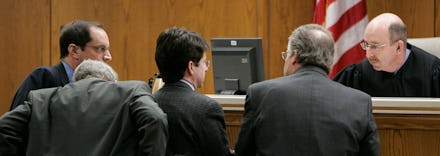Ken Kratz and the 7 Biggest Villains in Netflix's 'Making a Murderer'

As much as Making a Murderer viewers love the defense attorneys on Steven Avery's case, many of them have expressed disdain for the prosecutors and law enforcement officers involved in convicting both Avery and his nephew, Brendan Dassey, for Teresa Halbach's 2005 murder. Thanks to the Netflix documentary series, the internet erupted in memes that skewer Wisconsin's seemingly flawed criminal justice proceedings, the special prosecutor's Yelp reputation will never recover and petitions are circulating to secure a presidential pardon for Avery and Dassey.
For the uninitiated few who have yet to take a trip down the true crime rabbit hole, here are the eight people the internet has dubbed the villains of Making a Murderer. Certainly, there are more, but we don't want to ruin all the viewing fun.
Read more:
1. Ken Kratz
Having served as special prosecutor on the Halbach case, Ken Kratz is perhaps the most obvious person to blame for both Avery and Dassey's convictions. However, that's not the only reason he's become a magnet for the internet's ire. At the time of the Halbach trials, Kratz was the district attorney of Calumet County; unfortunately for him, though, a sexual harassment scandal led him to resign his post in 2010 and to the suspension of his law license in 2014. Kratz had allegedly sent a client of his — a victim of domestic abuse — salacious text messages, one of which reportedly read, "I have the $350,000 house. I have the 6-figure career. You may be the tall, young, hot nymph, but I am the prize!"
As it turned out, this wasn't the first time Kratz may have indecently propositioned women while on the job. Kratz's single-minded prosecution of the Halbach case, his sustained complaint that the documentary's portrayal of him was unfair and his alleged history of sexual harassment make him Making a Murderer's villain No. 1.
2. Investigative duo Lt. James Lenk and Sgt. Andrew Colborn
Manitowoc County Sheriff's Department employees Lt. James Lenk and Sgt. Andrew Colborn were pegged as linchpins in the possible planting of evidence during law enforcement's extended search of the Avery compound in 2005. When the defense suggested that the evidence found in Avery's trailer had been planted, both Lenk and Colborn denied the accusation. Both officers had been suspected of ignoring evidence that could have overturned Avery's wrongful 1985 conviction, and because they had recently been deposed in the course of his subsequent $36 million lawsuit, neither were supposed to be involved in the investigation. Yet it was Lenk who discovered literal key evidence in Avery's trailer, days into the search.
The lieutenant was also questioned about tampering with a vile of Avery's blood that had been in the county clerk office's possession. Colborn, for his part, was made to testify about a shady call he made on Nov. 3, 2005, in which he reported the license plates on Halbach's missing vehicle before it was found. For all these reasons, Anonymous has vowed to bring the pair down.
3. Special Agent Tom Fassbender and Sgt. Mark Wiegert
Viewers will remember Special Agent Tom Fassbender and Calumet County Sheriff's Office Sgt. Mark Wiegert from their questioning of 16-year-old Brendan Dassey, in which they extracted what has since been deemed a fanciful version of the events leading up to Halbach's murder. Many fans wondered whether it was legal to interrogate the teenager without a parent, legal guardian or attorney present. It was, but their handling of the situation felt coercive. The documentary shows the two investigators telling Dassey they knew what had happened, that they're help him if he told them the truth and peppering him with questions leading him toward their conclusion. Because of their influence, Dassey issued what could be considered a false confession: His low IQ and young age make him a prime target for police manipulation.
4. Len Kachinsky and his investigator, Mike O'Kelly
Len Kachinsky — Dassey's original court-appointed lawyer — has been labeled "evil incarnate" for his failure to fight for his client's innocence and his orchestration of a one-on-one interview between Dassey and Mike O'Kelly, whom Kachinsky hand-picked for the job. In the course of this interrogation, Dassey presents a detailed alibi that O'Kelly refuses to accept, instructing him to decorate the confession document with drawings that support his original story. The move was depicted in the documentary as an effort to work with the officers investigating Dassey, which is not what a defense attorney is supposed to do — which is why Kachinsky was subsequently removed from Dassey's case.
Later, when called to testify, O'Kelly put on a waterworks show that ultimately failed to distract from the allegation that he'd coerced Dassey's confession (for which no concrete evidence ever surfaced).
5. Gene Kusche
Who could forget the Manitowoc County Chief Deputy Sheriff-cum-sleeper-artiste implicated in convicting Avery of the 1985 sexual assault he didn't commit? After questioning the sexual assault victim — Penny Beernsten — Gene Kusche drew the composite sketch that then was used to peg Avery as the likely culprit. As the documentary demonstrates, though, the sketch didn't actually resemble Avery at the time the crime was committed. It did, however, look a lot like an earlier mugshot of Avery, to which law enforcement had access. Swearing he'd never seen such an image before he drew the sketch — which he later framed and hung in his office — Kusche stood by his story, saying that he was merely the hand that holds the pen; that he'd drawn what had been described; that DNA evidence couldn't prove Avery's innocence because DNA evidence could be fabricated or tampered with. Oh, the irony. It is so rich.
Correction: Dec. 5, 2015